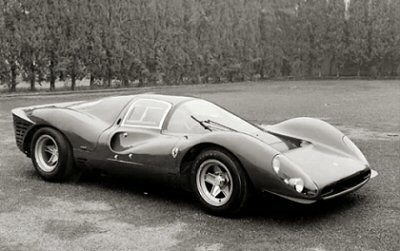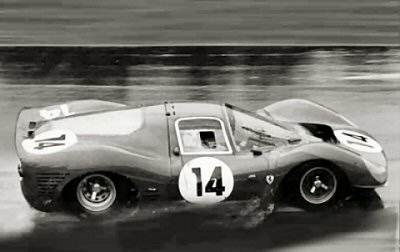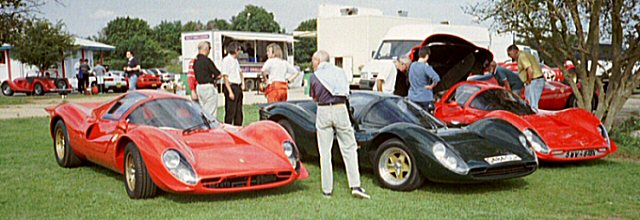P4 Intro
We have to
go back to the sixties to understand a little of the passions aroused
around these cars. This is really about Le Mans too - the world's premier
endurance race - and the clash of the Titans in this era. Two of the
all time enduring automotive shapes went head to head. For three seasons
Ford and Ferrari flexed their engineering muscles - as well as their
bank balances - and took each other on for the automotive sports car
endurance crown. Well that's the fable anyway. These clashes weren't
quite as regular as that, and the significant ones didn't all happen
at Le Mans. But we're not going to spoil a saga for a few facts....
The venue was, as the legend goes, Le Mans - and that unique, crazy
circus that makes up the 24 heures du Mans.
The two cars
I have in my minds eye are the Ford GT40 and the Ferrari 330 P3 /P4.
Both born of, and borne by, the demands of the 200mph plus Mulsane straight
(then chicane-less) - in addition to the fashions and talents of their
designers and racers.
It is the Ferrari
330 P4 we look at here. Of course to try and buy a real one has long
been out of the question. They fetch prices that wouldn't disgrace an
auction of European Grand Masters' paintings. But there is a father
and son business in Kent that have quietly built up their business making
kits of these magnificent beasts. And if you're lacking a car project
you really fancy, and can look to a couple of years in your ample garage
to bring it all together. This is really one car to see.
P4
History
Background
Somewhere in
my past, someone showed me a black and white photo. It was of the finish
of the 1967 (I think '67) at Daytona from somewhere behind the finish
line. And crossing the line, in formation, were three Ferraris. My first
thought, as I remember, was why one of them had removed its roof. In
fact it was an opened topped Can-Am car - or Spyder as Ferrari in the
States would have it. Was this the first time anyone had thought to
fix the finish so the winning team brought their steeds around in formation?
No - I think they were mimicking and still smarting from Ford's behaviour
at Le Mans the previous year.
Yet there was
something about those cars in the photo. I get as disturbed by the look
of some cars as I do with beautiful women. The same sort of forms lock
into me - I never forget either. Here it's car porn. A closer look at
this monochrome photo showed how un-naturally low were the bonnets of
these cars. How the proportion of the front and grill were just right.
Broken only by those magnificent upward curves that shroud the front
wheels, with the cockpit nestling behind. The dome shaped windscreen
and roof was rounded and small - uncomfortably small for the occupant
perhaps. Like the line of the best of graceful ships it all looked very
right. Nothing out of balance.
Why does this
image endure? Partly from the shear shocking beauty of the cars. Partly
because I realised afterwards how often I kept seeing it repeated. Ferrari
had imprinted these curves on my brain. Similar curves and angles were
being produced on the road going varieties of Ferraris of the time.
But for them these curves were more about fashion. The P3/P4 was the
original. The original 'old block' for all the prancing horse 'chips'.
The road going Dinos 365s etc. are very pretty, but pale imitations
of this shape. The P3/P4 is another case of form following function
- even if saying this is to dismiss all too easily the artistic talents
of their coach builders.
But also these
cars represented another automotive engineering step forward. The technology
for longitudinal mid-engines had arrived. And it was Ferrari's departure
to mid engines that spurred on a group of British designers and racers
to respond to Ford and help build the GT40.
A third reason
is the later growth of the sports supercar as an iconic image. Proper
car porn. This is mixed with the modern capabilities for controlling
large wedges of torque and power. Later engine, tyre and material technologies
now allow us to contemplate building a look-alike with tractable enough
performance to delight, yet allow us to control it on the road.
 Ferrari's
- 'Those Fast Little Red Cars'
Ferrari's
- 'Those Fast Little Red Cars'
For the genetic
history to this car I'll refer you to Ferrari sites that will quote
the car type numbers etc at you with many images until you run out of
RAM. I'll leave links at the bottom of the page.
This episode
in Ferrari history is really about Henry Ford's
attempt to do something about "Those fast little red cars"
and the consequences of the actions that followed.
For our 'one
stop read' however, we could note three major points...
Front-engined
for Road - Mid-engined for Racers
Firstly the
early sixties Ferrari 250 GT series - hugely successful in all senses
- was really the last road car design turned to racing. It had a glorious
V12 engine - situated at the front of the car. It looks, sounds and
drives like an up-market Jaguar E type. (That should be read as a compliment
to both cars). From this time onwards the bloodline for road and sports
racers divides... as engine configuration, space frames and aerodynamics
drives the racer's development away from the road car buyer's expectations.
The Ferrari 250 GT series had a large impact on the American market
- and Ford in particular. It certainly was a cause of the reaction provoked
within Ford. We could debate how different some of the new Ferrari models
actually were, but they were generally a commercial success.
Today the shock
factor of the new shaped mid-engined cars is easy to dismiss. Our senses
our dulled after decades of similar sports cars have reduced the look
to merely 'normal'. At its time, the P3/P4 was leading edge, radical
stuff.
The 330
Road Car Lineage
Secondly the
Ferrari 330 series after which the race cars are named was launched
in 1963. We have to look to the States as the premier Ferrari market.
The first road car with the '330' badge was the 330 America. It was
basically a re-engined 250 GTE 2+2 which, apart from the new 4-litre
engine, featured virtually no changes, the only visible one being the
'330 America' badge on the boot lid. A total of 50 cars were built.
The replacement for the 250 GTE 2+2 was launched in January 1964. The
new car was known as the 330 GT 2+2. It was still heavily based on the
250 series styling and looks. It featured a development of the old chassis
- extended by 50mm, but had different nose and tail designs by Pininfarina.
The changes did not meet with complete buyer and dealer approval.....
In 1965 the four-speed with overdrive transmission was replaced by a
five-speed unit, new wheels were introduced and, most significantly,
a new nose design with only two headlights replaced the previous slanted
four-light setup. Numerous other minor details were also changed. Production
continued until 1967 when a total of 1075 cars were sold. It was replaced
with the 365.
|
|
| Ferrari
had proved to be a dominant force in endurance racing. Ford decided
to break their grip on the sport. Initially Ford attempted to
buy out Ferrari (a move that was to see Ferrari in partnership
negotiations with Fiat soon after).
When
negotiations failed, Ford set out to beat them on the track.This
was no simple marketing rivalry. The amount of resources Ford
used made it clear this was intended to be a multi-national conglomerate's
knock out blow. Hence the antagonism.
Ford
used the British Lola Mk6 as the basic design - and the Ford GT
programme was born. The GT made its debut at Le Mans in 1964.
None of the Ford cars finished the prototype classes - but Ford's
AC Cobra Daytona Coupe beat the Ferrari GTOs in the GT class.
Ford's
basic strategy was to up the engine capacity to gain pace. Ferrari
improved their cylinder heads and increased the V12's efficiency
with fuel injection - and eventually three valves per cylinder
designs.
In
1965 Ford fielded a 7 litre GT40 at Le Mans. Would Ferrari's little
4litre V12 P2 Spyder be enough? Both teams failed - the best placed
being a P2 in 7th position.
For
1966 revised screen width regulations encouraged Ferrari to seek
even better aerodynamics. 3 sleek lightweight P3s were prepared.
Despite early season successes Ford achieved a 1-2-3 at Le Mans
following P3 retirements before hour 17 of the race.
Within
6 months Ferrari had developed the P4. It's main difference was
the 4 litre engine - same capacity but now derived from the Formula
1 3 litre engines. Two unfinished P3s were also converted to P4
spec and named 412 Ps. These machines were again up against the
newly revised Ford GT40 MkIVs. Ford had new honeycombe cell aluminium
chassis and more powerful engines available at Le Mans. And one
GT40 survived ahead of two P4s for the podium.
Ferrari
lost Le Mans but had done enough during the year to win the World
Endurance Championship for the 12th time in 14 seasons. Rule changes
made all these cars obsolete for the following year.
The
Ford v Ferrari 'grudge match' was over. |
1966 saw the
release of two new 330 models, the GTC at Geneva and the GTS at Paris.
The 330 GTS, a spider, was basically a mildly makeover-ed and re-engined
275 GTS with a 4-litre engine. The 330 GTC, a two-seat coupé,
relied heavily on the mechanicals of the 275 GTB, as it used the same
chassis and transmission, but with a new body by Pininfarina. Although
new, the body was broadly similar to the 275 with certain details following
the 330 GT 2+2. Around 600 examples of the coupé and 100 examples
of the spider were built before production stopped in 1968. The replacements
were the 365GTC/4 and 365 GTS respectively.
Ferrari
'P' Gene-ous
Thirdly is
the evolution of Ferrari's racing sports prototypes themselves. Ferrari
had retained their position at the top of the endurance racing during
the late fifties. When John Cooper overturned the Formula 1 world with
his little mid-engined F1 1500cc racers, in the late 1950s, Ferrari
had been caught off guard.
Enzo Ferrari
learned from this setback and focused on endurance racing to promote
his prancing horse cars. He made sure Ferrari kept the upper hand in
sportscar racing with a number of V6 and V12 mid engined prototypes.
The first of these was the Dino 246 SP, first seen in 1961. In 1963,
with two years development and racing completed, the first V12 engined
car was launched. This was the 250 P. During the rest of the sixties,
the P-series would form the backbone of Ferrari's sportscar and endurance
programmes. The last front engined Ferrari won at Le Mans in 1962. The
250 P took the first ever mid-engined win a year later.
[We
might also note just how exclusive these cars were. They were built
in handfuls. There were never more than a few of any made.]
Ford's assault
on this situation began in 1964. A summary is provided in the adjacent
table. We continue here with the advent of the 330 P3 in 1966.
For the 1966 season the FIA had dropped the minimum windscreen width
requirements. In a quest to gain more aerodynamic efficiency - and increase
the car's top speed - the P3's famous curving narrow windscreen was
designed. This was said to gain 15 km/h on top speed.
Ferrari also
revise the P2 body shape to suit the new regulations and match the GT40's
top speed. The P3 also featured fiberglass doors. This was another first
for Ferrari over aluminum sheeting used on previous prototypes.
The clutch
was relocated from right behind the gearbox to between the gearbox and
engine. A new ZF 5 speed gearbox was installed replacing the four speed
box of the P2.
The
six Weber carburettors were also replaced by a Lucas fuel injection
system on the P3's engine. The engine provided
slightly more power, but a wider track added some weight, and the P3
had a similar power to weight ratio to the P2.
Results in
the opening races of the season were promising. Piloted by Mike Parkes
and respectively John Surtees and Ludovico Scarfiotti the P3 won the
1000 km races at Monza and Spa. Luck ran low for Ferrari as factory
labour problems delayed preparations for the 24 Heures du Mans. Down
on development time, none of the P3s made it past the 17th hour of the
race. In contrast, Ford obtained a stunning 1-2-3 victory at Le Mans,
a feat previously only matched by Ferrari themselves.
P4 Arrival
The fight was not over. Despite Ford's budget, Ferrari rapidly innovated
along proven avenues. The first tests with the P4 - the P3's replacement
were conducted in December just six months later. Apart from some cosmetic
changes the most important new part of the P4 was its engine. The engine
was still of 4 litres capacity, but now it was derived from the Ferrari
3 litre F1 engine. The cylinder head now sported 3 valves per cylinder,
one exhaust and two inlet valves. The Lucas fuel injection was moved
from between the cylinder banks to between the camshafts. The engine
was rated at 450 bhp at 8200 rpm. An in-house design of 5 speed gearbox
replaced the troublesome ZF item. Further streamlining and anti-lift
solutions were applied to the bodywork of the cars, in a search for
more top speed to counter Ford's advantage at Le Mans.

After exhaustive
testing at Daytona during December 1966, the P4 prototype was ready.
Two of the three P3s were fitted with P4 style bodywork and Weber carburettors.
Another two unfinished 330 P3s were built up to P4 specifications and
christened "412 P". All four of these cars were sold to Ferrari's
privateer teams - to back up the factory's own P4 effort - (NART, Filipinetti,
Francorchamps and Maranello Dealers).
Every option
was exploited to meet the Ford challenge Against the P4 Ford would field
the GT40 mkIV. But this car wasn't to be available until mid season.
Ford's eyes were very definitely on the Le Mans prize.
In February,
at Daytona, Ferrari took its revenge on Ford by winning at its home
ground. The three cars paraded after their monopoly of the podium places;
the Spider 330 P4 of Bandini/Amon, the Berlinette 330 P4 of Parkes/Scarfiotti
and the 412P of NART). The celebrated 330 P4 Spider's lines were crafted
by Mauro Forghiere in person.
The 330 P4
was not entered at Sebring, but was vital for Monza - Ferrari's 'home'
meeting. Ford remained absent here. Then Jacky Ickx won at a wet Spa
against the Ferraris. At LeMans, however, the fight would be more even.
As Ford's response was readied for the battle. After one of the all
time great races at Le Mans Ford was triumphant. Two Ford GT Mark IVs,
came in first and fourth, framing the Ferraris of Parkes/Scarfiotti
and Mairesse/Beurlys. In spite of this defeat, Ferrari was still ahead
of Ford in the World Endurance Championship with 31 points against Ford's
22. On the other hand, Porsche led with 32 points. The Ferraris were
entered at Brands Hatch to outscore their German rivals - who at this
time only had 2.2 litre race engines. With this victory at Brands Hatch,
Ferrari obtain the world title for the 12th time in 14 years.
Rule changes at the end of the season left the 330 P3, 330 P4 and 412
P obsolete. NART modified the P4 Spider (0844) to campaign in the CanAm
series, against the big American V8s. The 'Barchetta' racer was never
a real contender in the series even with engine capacity taken to just
under 4.2 litres, (resulting in a power output of around 480 bhp). Again
we are left to wonder at the shape and the noise of these great Ferraris.
And perhaps to wonder at their impact upon the sports supercar world
- with the realisation of just how few were ever built.

Building
a look-alike - the Foreman Mk4 and CanAm
So, if you
want to, you can honestly choose between eras for your third car. An
obvious seventies equivalent might be a Lancia Stratos. From the eighties
you might choose a second hand Porsche or TVR, lots of other options
have grown up in the nineties for this market niche - like a Noble for
instance. You might want ultimate performance for your car sport - in
which case the light weight Caterham or Westfield or bike engined Radical
might suit you... then you like pure grunt rather than pure porn for
your toy. But, more recently, it is no accident that Ford have announced
their reproduction of the Ford GT in 2003. This is the old GT40 with
new kit. Same shape, better engine management less vibration - and its
aimed at the open road first, not the race track! Providing
you can live with the lack of storage space and the sixties feel to
the whole experience - and you start with a reasonable bank balance
- there is also a P4 option to choose. You'll get just the most head
turningly unique looks with performance and handling to match. What
it won't be is a comfortable GT cruiser to match a modern Ferrari or
Aston Coupe. Test drive and understand before committing to it. This
will be the equivalent of car porn six inch high heels (er that's normally
for the ladies) and you must be prepared to trade some modern vibration-less
comforts to get the jackpot. It's not going to batter you around like
one of the four wheel Caterham/ Westfield etc bikes, but it is still
a racer at heart. Comprende?
Without N F
Auto Development and the Foremans we would be condemned to looking at
fading photos or websites full of various 1/24th scale models, etc.
On one of our SFC track day adventures a few years back we rubbed shoulders
with the Foremans and a stand full of their show cars. It was a track
day for classics at Castle Combe. There's always a great diversity of
cars of all ages at this late Summer meeting. And these cars stood out
like the thoroughbreds they are. It is even more of a shock when one
of these replicas is parked next to a Triumph Herald, Austin 1100, and
a Jag Mk5 saloon - and you realise these designs were all in 'production'
in the same year!
Now before
venturing into motorsport I honed my GRP skills on Rochdales, TVRs,
Ginettas and several other sorts of project - including a hovercraft.
So I'm no novice when it comes to GRP and moulds. These cars are basically
solid - well made. The P4 shape suits this material - with its abundance
of self-supporting convex curves.

One day I thought,
I might actually enjoy doing one of these. In my case, of course, the
real problem is the number of car projects ahead of it. But with that
thought in mind I had a test drive in two and a passenger ride in the
other.
| N
F Auto Developments |
NF
Auto Developments was established in 1991 after Neil Foreman
had built himself a spectacular Ferrari P4 replica. By 1998
the company had completed development of its own P4-inspired
replica. They operate from workshops, in the heart of Kent.
Here
Neil and his son Matthew undertake full builds and kit manufacture.
NF Autos also undertakes a wide variety of specialist automotive
engineering work on both production cars and kits. The company
has its own paint shop and has generally developed a reputation
for tackling one-off fabrication jobs that few others can deal
with.
More
recently they have grown a parallel business offering general
parts and tools for many car projects and accessories called
Car Builder Solutions.
More
recently Neil has even begun a new helicopter business too.
|
SFC
Gallery
Page
Links

